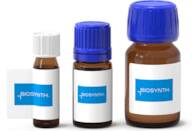
Acetyl-Alpha-synuclein (1-13) Met5(O) Heavy
Ref. 3D-CRB1301155
| 25nMol | 344,00 € |
Información del producto
- Ac-MDVF-[Met(O)]-KG-[U-13C6,15N-Leu]-SKAKE-acidAcetyl-Met-Asp-Val-Phe-[Met(O)]-Lys-Gly-[U-13C6,15N-Leu]-Ser-Lys-Ala-Lys-Glu-OH
Acetylated alpha-synuclein (1-13) is derived from the alpha-synuclein intrinsically disordered protein which is found in the neurons and presynaptic terminals. Encoded by the SNCA1/PARK1 gene alpha-synclein is structurally composed of 140 amino acids, making up the three domains: N-terminal membrane binding domain, a hydrophobic non-amyloid-β component domain and a hydrophilic C-terminal domain. Usually alpha-synuclein plays a role in protecting neurons from apoptotic stimuli and is involved in synaptic vesical trafficking.However it has been found that the accumulation of alpha-synuclein aggregates can lead to neurodegenerative diseases such as Parkinson's disease, dementia with Lewy bodies and multiple system atrophy. It is further involved in the fibrilisation of amyloid-b and tau which play a major role in Alzheimer's disease. Amyloid fibrils are formed from alpha synuclein monomers within the cytosol and when bound to membranes these monomers can undergo conformational changes to form protofibrils and then ring like oligomers. This can result in the formation of transmembrane pores which disrupts the membrane, calcium homeostasis and signalling.Alpha-synuclein can be subjected to the post-translational modifications of phosphorylation and N-terminal acetylation. When acetylation occurs at the N-terminus of an alpha-synuclein monomer, the intramolecular hydrogen bonds are altered thus reducing the rate of alpha-synuclein aggregation and the strength at which it interacts with the membrane is increased.The methionine at position 5 is oxidised and the oxidation of methionine is common in neurodegenerative diseases and promotes the accumulation of altered alpha-synuclein. Furthermore when these methionine residues are oxidised, methionine sulfoxides are produced. The leucine residue at position 8 is isotopically labelled with carbon-13(6) and nitrogen-15(1).
Propiedades químicas
Consulta técnica sobre: 3D-CRB1301155 Acetyl-Alpha-synuclein (1-13) Met5(O) Heavy
Si desea solicitar un presupuesto o realizar un pedido, por favor añada los productos deseados a su carrito y solicite un presupuesto o pedido desde el carrito. Es más rápido, más barato, y podrá beneficiarse de los descuentos y las ventajas disponibles.





